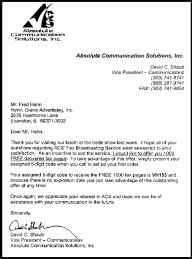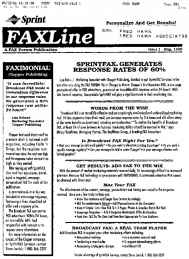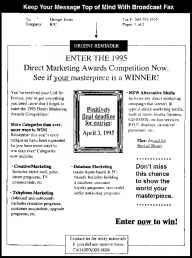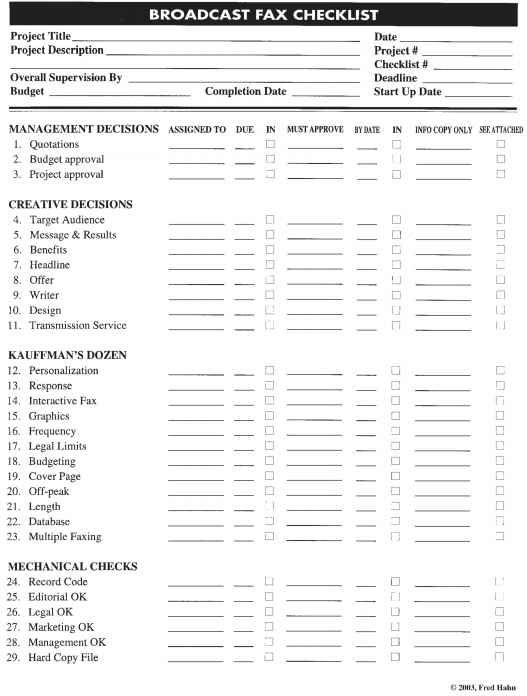Notes On The Broadcast Fax Checklist
These notes are a supplement to the material presented in this chapter. They are not a substitute for that material. The checklist is presented in Figure 10.3.

- A

Figure 10.2 (Copy at 200% for easy legibility.) A full-page cover certainly adds "class" but is seldom worth the extra cost. The simple "To" personalization in Figure 10.2B works just as well. If immediate sender identification is important, use a regular or modified letterhead as in the newsletter in Figure 10.2C. If you broadcast fax a newsletter, keep it brief and make sure it contains news that offers a benefit to the recipient as well as you. For self-puffery, stick to the mail.

- B
Figure 10.2 (Copy at 200% for easy legibility.) A full-page cover certainly adds "class" but is seldom worth the extra cost. The simple "To" personalization in Figure 10.2B works just as well. If immediate sender identification is important, use a regular or modified letterhead as in the newsletter in Figure 10.2C. If you broadcast fax a newsletter, keep it brief and make sure it contains news that offers a benefit to the recipient as well as you. For self-puffery, stick to the mail.
1. Quotations. The total of all quoted and/or estimated costs accepted from outside suppliers, plus the known or estimated internal out-of-pocket costs. This is the amount given for budget approval in #2.
2. Budget approval. The amount either accepted from #1, or otherwise determined as a fair cost to do the project. If lower than the figure in #1, costs may have to be renegotiated with suppliers or the project modified to fit the dollar allocation.
3. Project approval. Once the project can be done for the amount in #2, a decision on whether the project is worth the cost, no matter how "fair" the individual charges may be.
4. Target audience. Determination of the target audience at whom the fax is focused. Everything else about this fax must then be controlled by

- Figure 10.3 The broadcast fax checklist.
that focus. Do not use fax broadcasting for shotgun marketing or for prospecting. Do use it to market to your existing customer base or enclosed groups like tour organizations to travel agents or associations to their members.
5. Message and results. Give the reason for the message and the results it is to produce. This tells the writer what is to be said, not how to say it. The actual wording is the job of the writer in #9.
6. Benefits. The benefits offered in the message, keyed to the audience in #4. If none of those benefits seem particularly suited to that group, the choice of those benefits and why that particular audience was targeted must be reconsidered.
7. Headline. The headline's subject, not its wording. Pick the one thing most likely to attract the target audience; usually the key benefit from #6.
8. Offer. Give the recipient a major reason to respond now!
9. Writer. The checklist shows the person who appoints the writer. If certain things must be said in a specific way, let the writer know before he or she begins . . . and whether this is a legal constraint or a management decision. If the latter, management should be willing to at least consider alternatives.
10. Design. The person responsible for choosing the designer. This is a fax. Keep it simple and legible!
11. Transmission service. Before hiring your fax transmission service, get references for the quantity of work you need done. Don't just ask for references. Check them!
Kauffman's Dozen
12. Personalization. Fax personalization is critical. Name, company, and ID numbers can all be added to a personalized fax. If your database has a field, it can, as in Figure 10.2, be put practically anywhere on the fax.
13. Response. Add a response mechanism to your fax. "To get more information (or order), sign here and fax back" is just one example.
14. Interactive fax response (IFR). IFR, also known as fax on demand and document on demand, is usually handled by a broadcast fax company. It lets the fax recipient fax or call a toll-free number for frequently requested information. Callers can—usually within minutes, around the clock—get a return fax with up-to-the-minute information on product availability and price, order forms, product instructions, training materials, and so on.
15. Graphics. Keep the medium in mind when creating a fax. Photos and detailed graphics never fax well. Even fine lines may be a problem.
16. Frequency. Do not overuse the fax as a promotional tool. These documents have a sense of urgency that will lose their impact if you send everything by fax.
17. Legal limits. Know the limitations placed on fax broadcasting by the Telephone Consumer Protection Act. Find an attorney who specializes in this field.
18. Budgeting. Allocate 5 percent of your advertising budget to test broadcast fax. Programmed faxing should cost no more—and often less!— than a comparable document send by mail . . . and be delivered in hours, rather than days. Get knowledgeable help. Believe the results.
19. Cover page. Whenever possible, limit the use of a full-page cover page. Use a "headline" or Post-it™ note format.
20. Off-peak hours. Transmit during off-peak lowest-cost hours when possible, especially when sending multiple faxes.
21. Length. Send as few pages as possible. A single page is most likely to get read. Single-space most documents. Cut down on white space, but don't jam so much onto a page it becomes uninviting to the eye or hard to read. If you use a typesetting format, make the text at least 12 points in size.
22. Database. Establish a system to keep your database up to date. Use it!
23. Multiple faxing. Use a broadcast fax service bureau with the staff and equipment to do the job right. You'll save countless headaches and countable money.
24—28. Mechanical checks. Someone has to be responsible for checking each of these items before anything may be sent. Make sure that they do check them and sign off in writing.
29. Hard copy file. Some one person must be responsible for maintaining a hard copy file of all fax "as broadcast"; that is, as they actually appeared.
Was this article helpful?